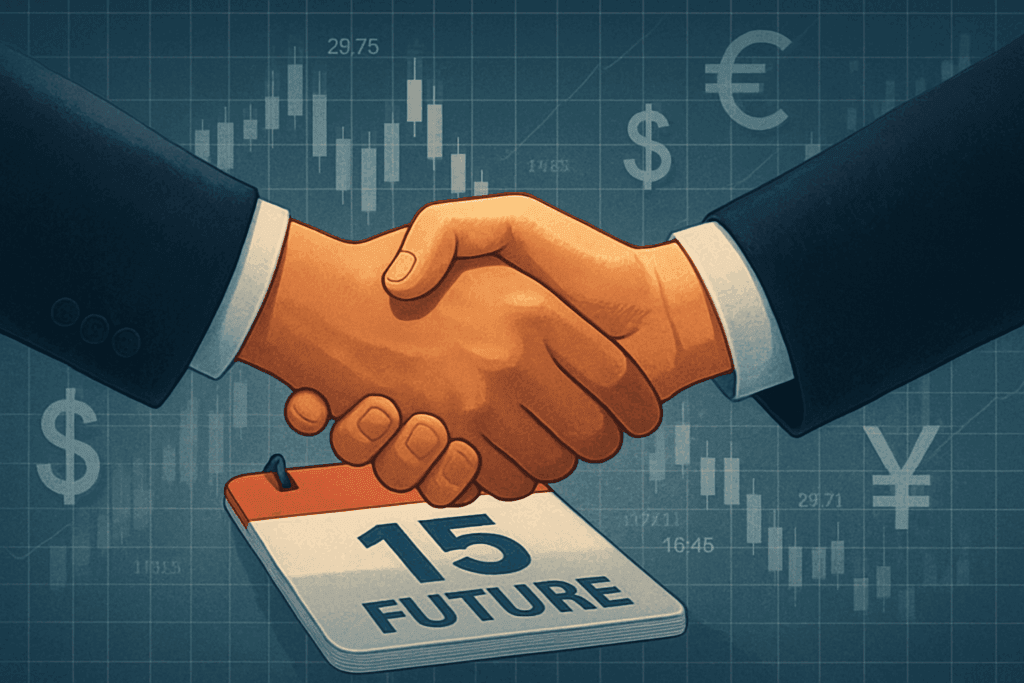Futures trading might sound complex, but it’s actually a straightforward concept that plays a crucial role in modern financial markets. Whether you’re an investor looking to diversify your portfolio or someone curious about advanced trading strategies, understanding futures can open new doors to financial opportunities.

What is Futures Trading?
Think of a futures trading as making a promise to buy or sell something at a specific price on a predetermined date in the future. It’s like placing a pre-order for your favorite gadget – you agree to pay a certain amount today for delivery later, regardless of whether the price goes up or down in the meantime.
In financial terms, futures trading is legally binding agreements between two parties. One party agrees to buy an asset, while the other commits to sell it at an agreed-upon price when the contract expires. This arrangement works for various assets, from stocks and commodities to currencies and even weather patterns.
The Mechanics of Futures Trading
Futures markets operate on standardized contracts, which means every contract for the same asset has identical terms regarding quantity, quality, and delivery specifications. This standardization makes trading efficient and transparent.
Contract Specifications
Every futures contract comes with specific details that traders need to understand. These include the contract size (how much of the asset you’re trading), the expiration date, and the tick size (minimum price movement). For instance, a single S&P 500 futures contract might represent $50 times the index value.
Expiration and Settlement
Most futures contracts have quarterly expiration dates – typically March, June, September, and December. The contract closest to expiration, called the “front-month” contract, usually sees the most trading activity. As expiration approaches, active traders often “roll over” their positions to the next contract month to maintain their market exposure.
When contracts expire, settlement can occur in two ways. Physical delivery means you actually receive the underlying asset (common with commodities like oil or wheat). Cash settlement, more common with stock index futures, means the difference between the contract price and market price gets paid in cash.
Types of Underlying Assets
The diversity of futures markets is remarkable. Here are the main categories:
- Commodity Futures cover agricultural products like corn and wheat, energy products like crude oil and natural gas, and precious metals like gold and silver.
- Financial Futures include stock index futures (like those based on the S&P 500), individual stock futures, currency futures for major world currencies, and interest rate futures tied to government bonds.
- Emerging Markets now include cryptocurrency futures for Bitcoin and Ethereum, reflecting the evolving nature of modern finance.
Two Primary Uses of Futures
Speculation: Betting on Price Direction
Speculators use futures to profit from price movements without owning the underlying asset. If you believe oil prices will rise, you might buy oil futures. If prices increase as expected, you can sell your contract for a profit before expiration.
Consider this example: Suppose the S&P 500 index trades at 4,000 points, and you buy a futures contract expecting it to rise. If the index climbs to 4,200 points, your contract becomes more valuable, and you can sell it for a profit. Conversely, if the index falls to 3,800 points, you’d face a loss.
Hedging: Insurance Against Price Risk
Hedging uses futures as insurance against unfavorable price movements. Imagine you’re a portfolio manager overseeing $50 million invested in S&P 500 stocks. Worried about a potential market decline, you could sell S&P 500 futures contracts. If the market drops, your portfolio loses value, but your futures position gains value, offsetting much of the loss.
This strategy works in reverse too. If the market rises, your portfolio gains value while your futures position loses money. The key is that hedging prioritizes protection over maximum profit.
The Role of Leverage and Margin
One defining characteristic of futures trading is leverage. Instead of paying the full contract value upfront, traders post a margin – typically 5% to 15% of the contract’s total value. This margin acts as a good faith deposit, allowing you to control much larger positions than your account balance might otherwise permit.
While leverage amplifies potential profits, it equally magnifies potential losses. A small adverse price movement can result in losses exceeding your initial margin deposit. This double-edged nature makes risk management crucial in futures trading.
Advantages of Futures Trading
- High Leverage allows traders to control significant positions with relatively small capital investments, potentially amplifying returns when trades work out favorably.
- Market Access extends beyond traditional stock market hours, with many futures markets operating nearly 24 hours a day, allowing traders to respond quickly to global events.
- Diversification opportunities abound, as futures markets cover asset classes that might be difficult or expensive to access directly.
- Hedging Capabilities provide valuable risk management tools for investors and businesses exposed to price volatility.
- Liquidity in major futures markets ensures traders can enter and exit positions efficiently without significantly impacting prices.
Potential Drawbacks and Risks
- Leverage Risk works both ways – while it can amplify gains, it can also lead to substantial losses that exceed initial investments.
- Complexity requires a solid understanding of contract specifications, margin requirements, and market dynamics before trading.
- Volatility can be extreme, with daily price swings that might be uncomfortable for conservative investors.
- Opportunity Cost exists with hedging strategies, as protective positions may limit upside potential when markets move favorably.
- Time Sensitivity matters greatly, as contracts have expiration dates that can force unwanted decisions if not managed properly.
Regulatory Framework
The Commodity Futures Trading Commission (CFTC) oversees futures markets in the United States. Established in 1974, the CFTC works to maintain market integrity, prevent manipulation, and ensure fair trading practices. This regulatory oversight provides important protections for market participants.
Futures vs. Other Investment Vehicles
- Compared to Stocks: Futures offer higher leverage and extended trading hours but carry greater risk and complexity.
- Compared to Options: Futures create binding obligations for both parties, while options provide rights without obligations (for buyers). This makes futures potentially more profitable but also riskier.
- Compared to ETFs: Futures allow direct exposure to specific assets or indices with high leverage, while ETFs provide diversified exposure with lower leverage and simpler structure.
Getting Started Considerations
Before entering futures markets, consider your risk tolerance, available capital, and trading experience. Start with paper trading or small positions to understand market dynamics without significant financial exposure. Develop a clear trading plan that includes entry and exit strategies, risk management rules, and position sizing guidelines.
Education remains paramount. Successful futures trading requires understanding not just the mechanics but also the factors that drive price movements in your chosen markets. Whether you’re interested in agricultural commodities, stock indices, or currency futures, each market has unique characteristics worth studying.
Final Thoughts
Futures trading offers powerful tools for both speculation and risk management, but success requires careful preparation and disciplined execution. The combination of leverage, diverse market access, and sophisticated strategies makes futures attractive to many traders and investors.
However, the same features that create opportunities also generate risks. Before committing significant capital, ensure you understand the mechanics, have realistic expectations, and possess adequate risk management skills. With proper preparation and ongoing education, futures trading can become a valuable component of a well-rounded investment approach.
Remember that markets can be unpredictable, and even the most carefully planned strategies sometimes fail. Never risk more than you can afford to lose, and consider consulting with financial professionals when developing your trading strategy.


